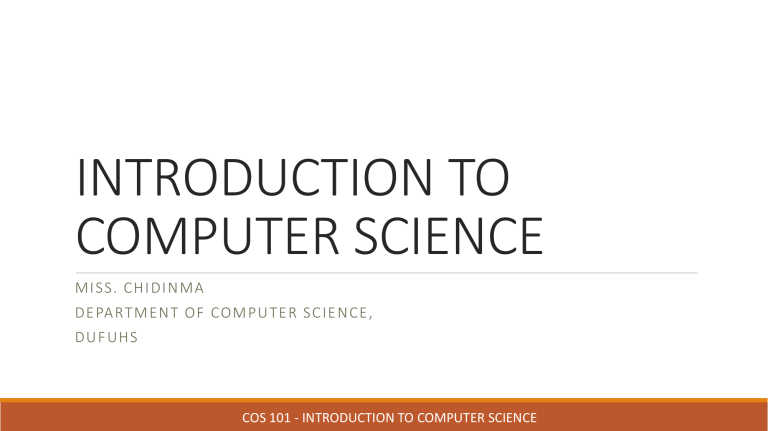
INTRODUCTION TO COMPUTER SCIENCE M I S S. CHI DI N MA DE PA RTMENT OF COM P U T ER S CI E NCE, DU F UHS COS 101 - INTRODUCTION TO COMPUTER SCIENCE OUTLINE Definition of computer and computing. Classification of computer based on size, data processed and purpose. Advantages and disadvantages of a computer. Applications of computer in different areas of human endeavors. COS 101 - INTRODUCTION TO COMPUTER SCIENCE Definition of Computer COS 101 - INTRODUCTION TO COMPUTER SCIENCE Computing Computing is the use of computers and algorithms to perform various tasks, including data processing, problem solving, and information retrieval, encompassing a wide range of applications from scientific research to everyday tasks. OR Computing includes designing and building hardware and software systems for a wide range of purposes. COS 101 - INTRODUCTION TO COMPUTER SCIENCE CLASSIFICATION OF COMPUTER SIZE • Micro Computer • Mini Computer • Mainframe Computer • Super Computer DATA PROCESSED • Analog Computer PURPOSE • Special Purpose • Digital Computer • Hybrid Computer • General Purpose COS 101 - INTRODUCTION TO COMPUTER SCIENCE SIZE (MICRO COMPUTER) It is also referred to as ―personal computers (PC). They are the smallest in size They are relatively cheap. They use one processor. The speed is determined by the number of size and configuration. Different OS. Consumes less power than the mainframe Desktop, Laptop COS 101 - INTRODUCTION TO COMPUTER SCIENCE SIZE (MINI COMPUTER) They are less in size than a mainframe but larger than a micro computer Less expensive than a mainframe. Faster than microcomputer Transaction processing, database management. Different OS. Consumes less power than the mainframe IBM system/3, PDP-11 is an example COS 101 - INTRODUCTION TO COMPUTER SCIENCE SIZE (MAINFRAME COMPUTER) They are less expensive than a supercomputer. They use multiprocessors (up to 7 cores per CPU) They do Trillion daily transactions. Bulky data processing like census, industry statistics. Linux OS IBM z14 – z16 is an example COS 101 - INTRODUCTION TO COMPUTER SCIENCE SIZE (SUPER COMPUTER) They are very expensive. They use parallel processing. They are extremely fast Tasking computations like weather forecasting. Linux OS Consumes a lot of Energy Cray-1 is an example COS 101 - INTRODUCTION TO COMPUTER SCIENCE DATA PROCESSED (ANALOG COMPUTER) Analog computers are specifically designed to process analog data. It is a type of continuous data that continually changes and does not have discrete values. It accepts the measuring device's data without converting it into relevant codes and numbers. Example is Speedometer, Thermometer COS 101 - INTRODUCTION TO COMPUTER SCIENCE DATA PROCESSED (DIGITAL COMPUTER) A Digital computer only understands the binary input 0 and 1. It converts all data to binary form Process discrete data. COS 101 - INTRODUCTION TO COMPUTER SCIENCE DATA PROCESSED (HYBRID COMPUTER) Combination of Analog and Digital Computer. Examples are Fuel vending machine, Electrocardiogram (ECG), Ultrasound Machine etc. COS 101 - INTRODUCTION TO COMPUTER SCIENCE PURPOSE (SPECIAL) These are developed with a specific purpose. Examples are: Automated teller machines (ATM), Washing Machine etc. COS 101 - INTRODUCTION TO COMPUTER SCIENCE PURPOSE (GENERAL) These are developed to meet the requirements of several areas such as simulation, solving mathematical equations, payroll and personnel database. COS 101 - INTRODUCTION TO COMPUTER SCIENCE ADVANTAGES OF COMPUTER High Speed Accuracy Automation Security Storage Ease of Access Multitasking COS 101 - INTRODUCTION TO COMPUTER SCIENCE DISADVANTAGES OF COMPUTER Cyber-Crimes and bullying Health-Issues like Eye strain, back pain, headache, carpal tunnel syndrome (pain in the wrist and arm) etc. Fake News Lack of Concentration Can limit learning COS 101 - INTRODUCTION TO COMPUTER SCIENCE APPLICATION AREAS OF COMPUTER Education Entertainment Communication Banking Healthcare Transportation Defense (Missile control, smart weapons) Offices Engineering Designs Supermarket etc COS 101 - INTRODUCTION TO COMPUTER SCIENCE THANK YOU FOR LISTENING! COS 101 - INTRODUCTION TO COMPUTER SCIENCE





